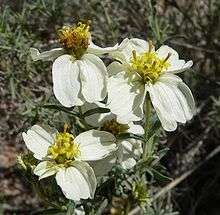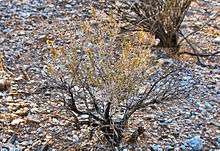Zinnia acerosa
Zinnia acerosa is a low-growing perennial flowering plant native to the Southwestern United States and Northern Mexico. Common names include desert zinnia, wild zinnia, white zinnia, and spinyleaf zinnia. It is a popular landscape plant in the southwest due to its low water use and long bloom period. The flowers also serve as a food source for southwestern butterflies.
| Zinnia acerosa | |
|---|---|
 | |
| Scientific classification | |
| Kingdom: | Plantae |
| Clade: | Tracheophytes |
| Clade: | Angiosperms |
| Clade: | Eudicots |
| Clade: | Asterids |
| Order: | Asterales |
| Family: | Asteraceae |
| Genus: | Zinnia |
| Species: | Z. acerosa |
| Binomial name | |
| Zinnia acerosa (DC.) A.Gray | |
| Synonyms[1] | |
| |
In the United States, Zinnia acerosa grows in Arizona, Utah, New Mexico, and Texas.[2] In Mexico, it has been found in Sonora, Chihuahua, Coahuila, Durango, Nuevo León, Zacatecas, and San Luis Potosí.[3]
Zinnia acerosa is a small, branching subshrub up to 16 cm (6.4 inches) tall. Leaves are very narrow, sometimes needle-shaped, up to 2 cm (0.8 inches) long. The plant produces flower head one per stem, each head with 4-7 yellow or white ray florets surrounding 8-13 yellow or purple disc florets.[3][4]
References
- The Plant List, Zinnia acerosa (DC.) A.Gray
- Biota of North America Program, 2014 county distribution map
- Flora of North America, Zinnia acerosa (de Candolle) A. Gray, 1852. Desert or shrubby or southern zinnia
- Conabio Zinnia acerosa (DC.) A. Gray Zinia del desierto (sugerido), ficha informativa in Spanish with photo plus description and ecological information
External links

| Wikimedia Commons has media related to Zinnia acerosa. |
| Wikispecies has information related to Zinnia acerosa |